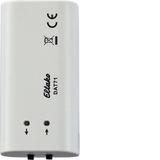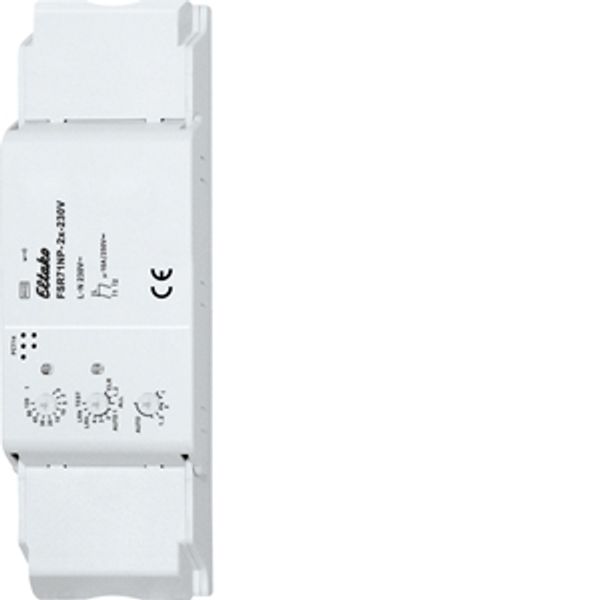Reģistrējieties, lai atbloķētu savas ekskluzīvās B2B cenas un sāktu iepirkties. Reģistrējieties tagad!
2 channel wireless actuator impulse switch with integr. relay function
Ir noliktavā: Nē
Piegādātāja krājumi: Nē
Minimālais pasūtījuma daudzums: 1
Cena (bez PVN):
94,91 €
EAN: 4010312316245
MPN: 30200865
Iepakojums: 1
Paredzamais piegādes laiks mūsu noliktavā (aptuveni):
Pēc pieprasījuma
Technical Information
| Preces stāvoklis | Jauns |
| Ražotāja nosaukums | Radio receiver ELTAKO 868MHz FSR71NP-2x-230V |
| Zīmols | ELTAKO |
| Kategorijas |
Gaismas slēdži
|
| Izcelsmes valsts | CN |
| Harmonizētās sistēmas kods | 8526 9200 00 |
| Montāžas metode | Citi |
| Krāsa | Balts |
| Nesatur halogēnus | Yes |
| Virsmas aizsardzība | Citi |
| Pašreizējais piedāvājums | 230 V MAIŅSTRĀVA |
| Releju skaits | 2 |
| Piemērots slēdzim | Yes |
| Piemērots pulsa pogai | Yes |
| Piemērots dimmeram | No |
| Piemērots rullo slēģu slēdzim | No |
| Materiāla kvalitāte | Termoplasts |
| Materiāls | Plastmasas |
| Stiprinājuma veids | Citi |
| Ritošā koda sistēma | - |
| Komandu skaits | 32 |
| Radio frekvences | 868 MHz |
| Mājoklī | Yes |
| Caurules pamatnes korpusā | No |
| Iespiedshēmas plate/modulis | No |
| Spiedpogas režīms | Yes |
| Pārslēgšanas režīms | Yes |
| Ar manuālo radio raidītāju | No |
| Ar radio kodēšanas ierīci | No |
| Ar radio vadāmu spiedpogu | No |
| Piemērots venēcisko/rullo slēģu slēdzim | No |
| Piemērots Venēcijas slēģu slēdzim | No |
| Caurspīdīgs | No |
| Virsmas apdare | Matt |
| Piemērots aizsardzības pakāpei (IP) | IP20 |
| Ir pieejams IFTTT atbalsts | No |
| Savietojams ar Apple HomeKit | No |
| Savietojams ar Google palīgu | No |
| Savietojams ar Amazon Alexa | No |
Iepakojuma informācija
| Iepakojuma līmenis 1 | 4010312316245, 4010312316245 |
| Iepakojuma līmenis 2 | 4010312316245 |
Lejupielādes
Apraksts
2-channel impulse switch with integrated relay function, 1 NO contact each not potential free 16A/250V AC, 230V LED lamps up to 400W, incandescent lamps 2000 watts. With light scene control by PC or wireless pushbuttons. Encrypted wireless, bidirectional wireless and repeater function are switchable. Only 0.8 watt standby loss. Mounting in the 230V power supply cord, e.g. in false ceilings and lamps. 166mm long, 46mm wide and 31mm high. With cable fixation. Maximum current as the sum of both contacts 16A. If supply voltage fails, the switching state is retained. When supply voltage is restored, the device is switched off in defined mode. The channels can be taught-in as ES and/or ER channel separately from each other. Scene control: Several channels of one or several FSR71NP-2x devices can be switched on or off in a scene by one of the four signals of a pushbutton with double rocker taught-in as a scene button. Central commands via app are sent using a Professional Smart Home controller. To do this, teach-in one or several FSR71NP-2x devices in the respective app. Use the rotary switches to teach-in the pushbuttons and test the 2 channels as required. For normal mode, the middle and lower rotary switches are then set to AUTO. With the upper rotary switch the EW time (0-120 seconds) is directly set for relays or the RV time (0-120 minutes) for impulse switches for all channels if necessary. If wireless motion/brightness sensors FBH (Master) and/or FBH (slave) are taught-in, the switching threshold will be set with the upper rotary switch, separated for each channel, at which the lighting will be switched on or off. Settings of the upper rotary switch in accordance with operating instructions. When wireless brightness sensors are taught-in, define the switching threshold separately for each channel using the top rotary switch. The switching threshold switches the lighting on or off depending on the brightness (from approx. 0 lux in position 0 to approx. 50lux in position 120). A hysteresis of approx. 300lux is permanently set for switch on/off. An additionally set RV time is not taken into account. Only one FBH or FAH is taught-in per channel. However, one FBH or FAH can be taught-in in several channels. When wireless window/door contacts FTK or window handle sensors FFG7B are taught-in, different functions can be set with the middle rotary switch in position AUTO 1 to AUTO 4 and linked to maximum 116 FTKs: AUTO 1 = window closed then output active. AUTO 2 = window open then output active. In settings AUTO 3 and AUTO 4 the FTKs taught-in to a single channel are linked automatically. With AUTO 3 all FTKs must be closed so that the N/O contact closes (e.g. for climate control). With AUTO 4 one open FTK is sufficient to close the N/O contact (e.g. for an alarm signal or to switch on the power supply for an extractor hood). One or several FTKs can be taught-in in several channels to allow several simultaneous functions in each FTK. After a power failure the link is restored by a new signal to the FTK and a signal on the next status message 15 minutes later. An additionally set RV time is not taken into account. When water probes are taught-in, a variety of functions can be set using the middle rotary switch in positions AUTO 1 to AUTO 4. AUTO 1 = no water, then NO contact closed. AUTO 2 = water, then NO contact closed. In Positions AUTO 3 and AUTO 4 the water probes taught-in to a single channel are interlinked automatically. With AUTO 3, all water probes must signal no water before the NO contact closes. The NO contact opens when a water probe signals water. With AUTO 4, the NO contact closes when a water probe signals water. Only when all water probes signal no water does the NO contact open. An additionally set RV time is ignored. The LED below the upper function rotary switch performs during the teach-in process according to the operating instructions. It shows control commands by short flickering during operation.
Piederums

In stock: No
ELTAKO
Data transformer for Series 71
65,34 €
EAN: 4010312316351
MPN: 30000026
Iepakojums: 1

